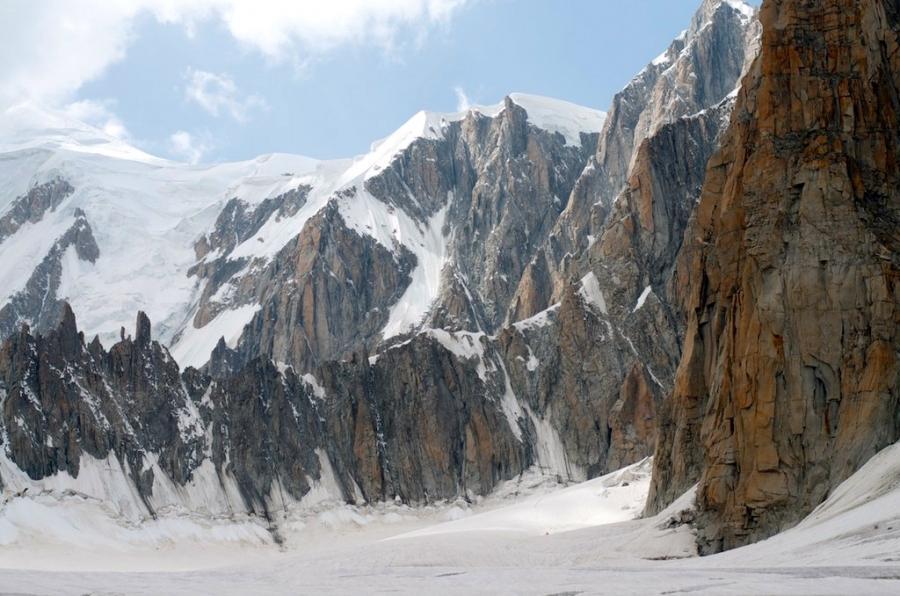Written by Matt Dickinson
18th October 2016
alpine climbing, mountaineering, Mountain Tracks, Mountain Guide, Matt Dickinson
What does a mountain guide do on his or her day off?
The answer: Climbing of course. As far as I know, every one of the 150 British Mountain Guides chose there career because they are passionate about their sport and once they qualified professionally, there desire to climb in there time off never changed.
An IFMGA guide has to be an able all-rounder (and then there is the skiing, but that’s a different story). The work involves guiding clients on all types of ground: rock, ice, mixed and altitude climbs. However the type of climbing we prefer to do with our own time tends to be a little more specialist depending on the prefered flavour. As with any pursuit in life, we can only become an expert if we specialise. So individual specialisations are as diverse as its members. For example, BMG guides Olly Allen concentrates on hard sport climbing, mainly in France and Spain. Sandy Allen and Kenton Cool has mave made marks on the high altitude scene. Myself and Mike ‘Twid’ Turner prefer long free routes. Other guides such as the late Rodger Payne went in search for whole new areas.
Personal climbing levels vary hugely, but our common bond is simply a great passion to climb. One of the greatest aspects of our sport for the whole community is the comradery and ‘the scene’. The mountains and crags give us a focus and consequently the guides are a close and supportive bunch, this leads to a great deal of information sharing and support.
Every year there is a great amount ‘done’ by the British Mountain Guides, and 2012 has been no exception, our members climbing some fantastic route. These include Manzino ridge (Nanga Parbat), Hard Arteries (Alaskan Big wall), Devine Providence, The Fish, Putery Intergral, North Face of the Matterhorn, Freny Central Pillar, The West Pillar Schiderwetterhorn.
Here is a little bit about what I got up to in the past climbing year (Matt Dickinson).
The Alpine area has endless potential for the Alpine rock climber. The number of routes has boomed over the years, and the quality of the climbing if anything has improved as climbers have ventured away from loose natural lines, and created striking lines on the neighbouring clean faces. This is particularly notable in the Dolomites, Chamonix and the fantastic Swiss limestone of Wendenstock, Eiger and Ratikon. These places have become my favourite destinations for my own exploits. These venues offer a huge choice of long sport routes typically from 10 – 25 pitches. Typically the bolting is sparse, and demands a strong minded approach. Nothing beats the feeling of free climbing at your limit up an immaculate shield of rock, with a free hundred meters of fresh air beneath your feet!
In my spare time I managed to bag a hand full of great alpine free climbs, each offering a different and memorable experience.
I climbed ‘The Fish’ on the Marmolada in the Dolomites with Sheffield climber Nick Boden. The South face of Marmolada is one of the greatest walls in the world and a stunningly beautiful place. The Fish is a bold traditional climb of 20 pitches on excellent unfractured limestone.
Half way through the summer I was lacking a partner, so I set my sights on a solo ascent of ‘Voyage Sellon Gulliver’ on the Grand Capucin. In my youth I had done a couple of routes on the Capucin, and the immaculate orange granite had stuck in my mind. On my return visit I wasn’t disappointed. Gullivers is a fantastic line on the best quality rock imaginable.
Later in the summer myself and Gerry Gore climbed ‘La Chant du Cygne’ on the Eigers north face. The right hand side of the Eiger is home to a number of long rock routes of around 900m, mainly bolted and in impressive surroundings. Our route had 21 pitches between 6a and 7a+ and was a real challenge to complete in a day without getting benighted.
The most common question I am asked is ‘does being a guide affect my motivation to climb? Perhaps I am less inspired to climb the classic Mountaineering routes we climb for our work, but I am still hugely motivated to climb Alpine rock.
 Off-Piste
Off-Piste Ski Touring
Ski Touring Via Ferrata
Via Ferrata Ice Climbing
Ice Climbing Alpine Glacier Trekking
Alpine Glacier Trekking Worldwide Trekking
Worldwide Trekking




 Travel Website Development
Travel Website Development